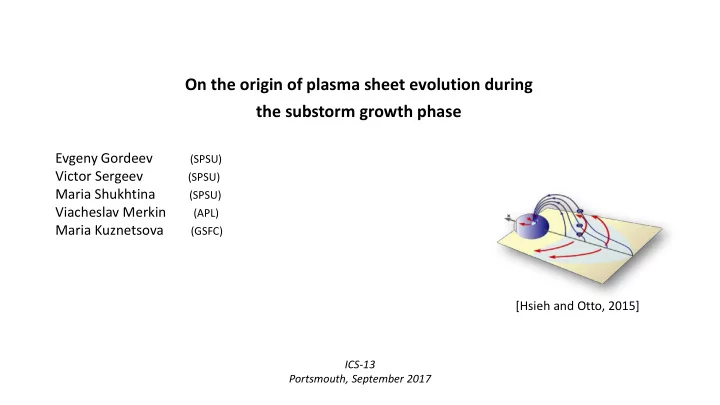

On the origin of plasma sheet evolution during the substorm growth phase Evgeny Gordeev (SPSU) Victor Sergeev (SPSU) Maria Shukhtina (SPSU) Viacheslav Merkin (APL) Maria Kuznetsova (GSFC) [Hsieh and Otto, 2015] ICS-13 Portsmouth, September 2017
Motivation All textbooks: main concept of CS evolution during GP – slow adiabatic compression of tail plasma sheet - 2D theory [Schindler and Birn, 1985, 1986, 1999] - 2D MHD & kinetic models [Ma et al., 1995; Birn et al., 1996; Pritchett and Coroniti, 1995; Hesse et al., 1996; Birn and Schindler, 2002] - Qualitative agreement with observations – slow increase of B Lobe with CS formation/enhancement [Petrukovich et al., 2000; Dmitrieva et al., 2004; Sergeev et al., 2012] On the other hand: number of studies show CS dynamics inconsistent with simple adiabatic compression - CS may evolve independently on B Lobe [Petrukovich et al., 2000; Saito et al., 2011; Snekvik et al., 2012] - Scaling of CS parameters does not fit 2D theory [Artemyev et al., 2016] Other sources of magnetic reconfiguration?
Background Finite box simulations J Bz Hsieh and Otto, 2015: 3D MHD, Special boundary conditions, Finite box Development of ideas of Coroniti and Kennel, 1973; Coroniti, 1985; Kan, 1990 Lobes loading only Closed magnetic flux evacuation only Combination of both Closed M-Flux transport to the dayside has larger contribution to magnetotail reconfiguration at r<15RE, than lobe compression does.
LFM global 3D MHD simulation, example №2 Among other publicly available CCMC models, the LFM most closely resembles generic substorm like behavior under chosen input conditions [Gordeev et al., 2017a] Equatorial plane - Convection develops from the dayside reconnection region - Covers inner magnetosphere and inner tail - Mid-tail convection stays suppressed until tail reconnection Δ F eq ≈ 0.1 -0.2 GWb - Closed flux evacuation to the dayside reconnection region (to replenish reconnected flux) - Development of CS in the inner tail
LFM global 3D MHD simulation, example №2 Ey in equatorial plane Ey = -(V × B) y - intensity of sunward convection - Develops from the dayside magnetopause - Fast and global response on closed field lines (1-2 min) - In 10-15 min reaches a quasi-steady level in the inner magnetosphere and inner-tail - Stays suppressed in the mid-tail Both time scales fit to observations [Ridley et al., 1998; Snekvik et al., 2017]
Statistical results: intensity of convection along the magnetotail Proportional to external driving Suppressed Inner tail magnetic reconfiguration during Growth Phase is controlled by outflow of closed magnetic flux toward dayside reconnection region (rather than by MF loading into the tail lobes)
Current sheet development - Different global structure - Depends on initial configuration (SW precondition) Highly dipolarized initial configuration ‘Bz hump’ + fast MF outflow from inner tail
Connection to reality: Jy-Bz hodograms in the tail current sheet Themis observations (R ~ 10-11 R E ) Inner tail CS , R~10 R E [Artemyev et al., 2016] // 18 LFM simulations // <a> = -1.8 ±0.8 - a kind of universal relationship of the current sheet evolution Does not fit with existing analytical GP models during an isolated MHD substorm - At this distance the Bz and Jy changes are significant! - Qualitatively similar behavior of Jy(Bz) comparing to observations - Jy(Bz) evolve under the same law (same power index, <a> = 1.8)
Connection to reality: magnetic flux variation in inner and middle tail - 19 GP isolated events - Direct B integration through the X = -7 R E - simultaneous Cluster + Geotail (2004-2014) and X = -20 R E tail cross-sections - In situ tail MF calculation [Shukhtina et al., 2009, 2016] Different rate of tail MF change in the inner- and mid-tail cross-sections Y X X = -20 R E mostly inflow of open MF through magnetopause - Qualitatively resemble MHD results (plasma sheet convection is highly suppressed) - Consistent with scenario considered X = - 7 R E combination of open MF inflow and closed MF outflow (intense sunward plasma sheet convection)
Concluding remarks - Inner tail reconfiguration is controlled by outflow of closed magnetic flux toward dayside reconnection region (rather than by MF loading into the tail lobes) - Sunward transport of magnetotail plasma tubes is essentially a 3d global process -> key role of global simulations to investigate magnetotail preparation for the onset Global magnetospheric convection properties: - Begins from the dayside magnetopause – evacuation of the closed magnetic flux to replenish reconnected flux - Has fast and global initial response on closed field lines (1-2 min) - In 10-15 min reaches (high) quasi-steady level in the inner magnetosphere and inner-tail region ~ order of magnitude ! - Proportional to external driving - Can develop CS with different global geometry - Time scales are consistent with observations - General CS evolution (Jy-Bz scaling) in transition region fits with observations - Supported by variation of magnetic flux in inner- and mid-tail distances Global MHD LFM model: - Evacuation of the closed magnetic flux to the dayside reconnection region is important /main process of inner tail reconfiguration during the GP (including formation of intense unstable CS) Gordeev, E., V. Sergeev, V. Merkin, and M. Kuznetsova (2017), On the origin of plasma sheet reconfiguration during the substorm growth phase, Geophys. Res. Lett., 44, doi:10.1002/2017GL074539.
Recommend
More recommend